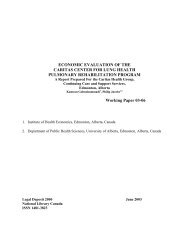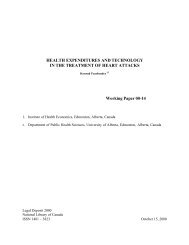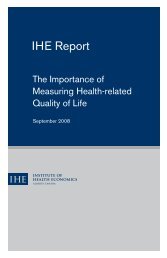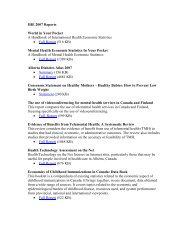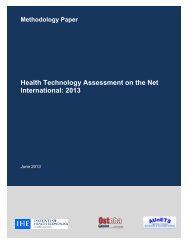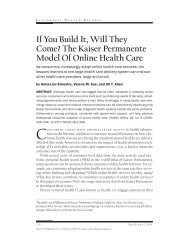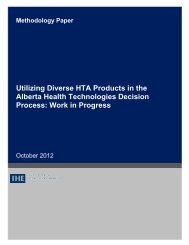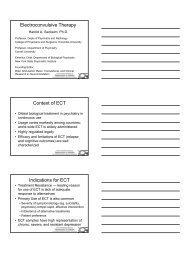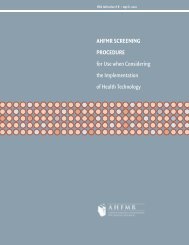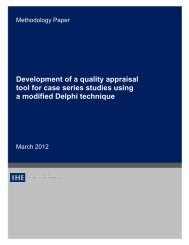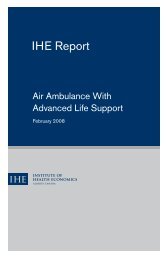DiscussionThe objectives <strong>of</strong> the economic analysis were:to determine the comparative cost-effectiveness <strong>of</strong> various bariatric treatment strategies <strong>for</strong><strong>obesity</strong> in <strong>adult</strong>s;to assess the economic burden <strong>of</strong> <strong>obesity</strong> in Alberta; to estimate the direct health services cost associated with bariatric surgery.Four types <strong>of</strong> bariatric interventions were identified in the literature review. These include bariatricsurgical procedures, pharmacotherapy, lifestyle modification, and weight management programs.The CADTH report constructed a Markov model to evaluate the cost-effectiveness <strong>of</strong> bariatricsurgery versus lifestyle modification or other bariatric surgical intervention <strong>for</strong> patients with a BMI≥ 40 kg/m 2 or a BMI ≥ 35 kg/m 2 with <strong>obesity</strong>-related comorbidities. This model applied clinicalevidence based on a systematic review and cost data collected from the provinces <strong>of</strong> Alberta andOntario and, there<strong>for</strong>e, can be generalized to an Alberta context. The model demonstrated thatbariatric surgery is cost-effective <strong>for</strong> patients with severe <strong>obesity</strong>, compared to lifestyle modification.Compared to lifestyle modification, the lifetime cost per QALY gained was $9398 <strong>for</strong> RYGB and$12,212 <strong>for</strong> LAGB. Moreover, surgery was particularly cost-effective <strong>for</strong> patients with <strong>obesity</strong>relatedcomorbidities. However, within bariatric surgical interventions, due to limitations in the dataavailable <strong>for</strong> analysis, the most effective type <strong>of</strong> bariatric surgery could not be identified.For studies that evaluated bariatric surgical procedures in comparison with lifestyle modification,bariatric surgery was demonstrated to be cost-effective <strong>for</strong> patients with a BMI ≥ 40 kg/m 2 or aBMI ≥ 35 kg/m 2 with <strong>obesity</strong>-related comorbidity. Results from the CADTH review 1 <strong>of</strong> theeconomic literature indicated that bariatric surgery was associated with a cost per QALY gained <strong>of</strong>$5000 to $40,000. Furthermore, there is evidence to indicate that the surgery is more cost-effective<strong>for</strong> <strong>obesity</strong> patients with T2DM. 4,7,13 Still, within bariatric surgical procedures, it is uncertain from theliterature which bariatric surgery is the most cost-effective.For studies that evaluated pharmacotherapy in comparison with no intervention, lifestylemodification or WMP, the pharmacotherapy was associated with the improvement in health benefit<strong>for</strong> treating patients with a BMI ≥ 30 kg/m 2 or a BMI ≥ 27 kg/m 2 with T2DM. However, the costeffectiveness<strong>of</strong> the comparisons varied, depended upon the specific medical conditions andinterventions being evaluated.For orlistat, as compared to no intervention, the cost per QALY gained was less than $18,881 <strong>for</strong>patients with T2DM; and compared with lifestyle modification, the cost per QALY gained was$28,631 <strong>for</strong> patients with impaired glucose tolerance (IGT). This suggested that orlistat treatment <strong>for</strong>obese patients with <strong>obesity</strong>-related morbidity was cost-effective. For the treatment <strong>of</strong> obese patientswithout <strong>obesity</strong>-related morbidity, and in comparison with LM alone, one study showed that orlistatplus LM was cost-effective 15 but three studies showed that the medication generated its healthbenefits at a greater cost, and there<strong>for</strong>e was less cost-effective. 14,16,21Of the studies evaluating sibutramine, three studies showed that, as compared to LM alone, the costper QALY gained, plus LM, was less than $18,486, suggesting the medication was cost-effective. 18-20By contrast, one study showed that the cost per QALY gained <strong>for</strong> sibutramine plus LM was $75,255as compared to LM alone, and $55,349 as compared to no intervention, suggesting the medicationwas not cost-effective. 17 Moreover, as compared to WMP, one study showed that sibutramine plusWMP generated a significant weight loss, but at no cost savings. 24<strong>Bariatric</strong> <strong>treatments</strong> <strong>for</strong> <strong>adult</strong> <strong>obesity</strong> 174
For studies that evaluated WMP, the specific interventions and patient population included in theevaluations varied. In a study conducted in the United States, a weight-wise intervention programwas compared to no intervention <strong>for</strong> low-income women with a BMI between 25 kg/m 2 and 45kg/m 2 . In another study, conducted in Spain, a walking program was compared with best care (thatis, routine care with a recommendation to increase physical activity) <strong>for</strong> moderately depressed elderlywomen with a BMI between 25 kg/m 2 and 39.9 kg/m 2 . However, in a study conducted in theNetherlands, a community-based intervention program was compared with intensive LM <strong>for</strong> thegeneral population and overweight individuals. All these studies showed that the WMPs were costeffective,when compared with no intervention or best care.For studies that evaluated various LM programs in comparison with other LM programs or notreatment, the patient populations and interventions under examination varied. For instance, someincluded GP or dietician counselling versus no counselling <strong>for</strong> patients with a BMI ≥ 30 kg/m 2 andwith a high risk <strong>for</strong> ischaemic heart disease (IHD), 28 while others compared LCD versus standarddiet <strong>for</strong> patients with a BMI ≥ 43 kg/m, 2,29 or diet and exercise versus lifestyle education <strong>for</strong> patientswith a BMI ≥ 28 kg/m 2 and knee osteoarthritis, 30 or lifestyle intervention versus standard care <strong>for</strong>patients with a BMI between 25 kg/m 2 and 35 kg/m. 2,31 (Refer to Results section <strong>for</strong> further detailsregarding these interventions.) Overall, the studies showed that LM was cost-effective with a costper QALY gained less than the conventional cost-effectiveness threshold <strong>of</strong> $50,000.The analysis <strong>of</strong> provincial health utilization data linked with the CCHS indicated that, compared tothe costs <strong>for</strong> individuals <strong>of</strong> normal weight, the health service costs associated with <strong>obesity</strong> areincreased by $217. This translates to an estimated $100 million economic burden <strong>of</strong> diseaseassociated with <strong>obesity</strong>. Furthermore, higher cost and resource utilization were associated withfactors including female, older age, lower household income, lower education, physical inactivity,and the presence <strong>of</strong> comorbidities.The analysis <strong>of</strong> provincial health utilization data indicated that the mean cost <strong>of</strong> inpatient andphysician services associated with bariatric surgery in 2006 was $12,176 per surgery. This analysisshowed that health service utilization and costs <strong>for</strong> the two years following surgery were greater than<strong>for</strong> the two years preceding surgery. However, when examining the marginal change in health serviceutilization and costs, the analysis showed an upward trend in the two years preceding surgery and adownward trend in the two years following surgery. Although this may suggest that bariatric surgerymay alter the upward trajectory <strong>of</strong> health service utilization <strong>for</strong> severely obese patients whounderwent surgery, it is important to note that the value in 2008 was still greater than that observedin 2005. Hence, it is uncertain whether the decrease is simply a return to pre-surgical levels. Still,these results are consistent with findings published elsewhere. In a US study 32 that examined thehealthcare utilization <strong>of</strong> inpatient services be<strong>for</strong>e and after RYGB, it was found that the rate <strong>of</strong>hospitalization in the year post-operation was more than double compared to the rate in the yearpreceding RYGY. Furthermore, in an observational study conducted in Québec, 33 a downward trendwas found in hospital costs over the five years following bariatric surgery.Importantly, the cost estimate <strong>of</strong> bariatric surgery does not include services that may have beenprovided prior to admission and after discharge from hospital (<strong>for</strong> example, pre-surgical counsellingconducted prior to admission to hospital and post-surgical support following discharge) due tounavailability <strong>of</strong> data at the time <strong>of</strong> the analysis. However, the CADTH review <strong>of</strong> bariatric surgerydid conduct a budget impact <strong>for</strong> RYGB or LAGB. 1 Cost categories included the cost <strong>of</strong> pre-surgicalconsultation (including bariatric specialist time, dietician follow-up, and laboratory and other testing)post-surgical follow-up with a bariatric specialist, surgery, hospital stay, and surgical complication.Cost categories did not include capital expenses <strong>for</strong> improving capacity, such as additional dedicated<strong>Bariatric</strong> <strong>treatments</strong> <strong>for</strong> <strong>adult</strong> <strong>obesity</strong> 175
- Page 1 and 2:
Alberta STE ReportBariatric treatme
- Page 3 and 4:
Alberta STE ReportBariatric treatme
- Page 5 and 6:
EXECUTIVE SUMMARYSocial and System
- Page 7 and 8:
Three surgical procedures—adjusta
- Page 9:
Costs of Bariatric Surgery and Pote
- Page 12 and 13:
Regulatory status .................
- Page 14 and 15:
TABLES AND FIGURESSection One: Soci
- Page 16 and 17:
ABBREVIATIONSAll abbreviations that
- Page 18 and 19:
LYMmMAMDMUHCNANHLBINHSNICENIHNNHNPH
- Page 20 and 21:
Bariatric physician: a licensed Doc
- Page 22 and 23:
High-density lipoprotein (HDL): a f
- Page 24 and 25:
Very-low-calorie diet (VLCD): a die
- Page 26 and 27:
Additional Internet searches were c
- Page 28 and 29:
This report addresses obesity in ad
- Page 30 and 31:
Many systemic factors have been ide
- Page 32 and 33:
Severe obesity is associated with d
- Page 34 and 35:
eport their height and under-report
- Page 36 and 37:
Also using self-reported data from
- Page 38 and 39:
An examination of overall obesity d
- Page 40 and 41:
Table S.2 presents the associationa
- Page 42 and 43:
• have multiple focal points and
- Page 45 and 46:
The main problem in any weight mana
- Page 47:
food, and a negative body image. As
- Page 50 and 51:
directly causes death. 61 To the ex
- Page 52 and 53:
The addition of a selected pharmaco
- Page 54 and 55:
lack of formal training in nutritio
- Page 56 and 57:
slightly more likely to have prescr
- Page 58 and 59:
selection criteria, have facilities
- Page 60 and 61:
Barriers to using appropriate baria
- Page 62 and 63:
Overview of adult obesityOver the p
- Page 64 and 65:
the need for regular physical activ
- Page 66 and 67:
phenylpropanolamine/25. Sibutramine
- Page 68 and 69:
Complianceand AdherenceDemand andut
- Page 70 and 71:
Aetna Clinical PolicyBulletinswww.a
- Page 72 and 73:
Overweight 123,821 172,971 157,623
- Page 74 and 75:
REFERENCES1. 2006 Canadian clinical
- Page 76 and 77:
34. Gostin LO. Fast and supersized:
- Page 78 and 79:
69. Klarenbach S, Padwal R, Wiebe N
- Page 80 and 81:
105. Hill JO, Thompson H, Wyatt H.
- Page 82 and 83:
141. Ross R, Bradshaw AJ. The futur
- Page 84 and 85:
172. Arkinson J, Ji H, Fallah S, Pe
- Page 86 and 87:
This section will address a set of
- Page 88 and 89:
dietary therapy is to reduce total
- Page 90 and 91:
Additional benefits of exercise ove
- Page 92 and 93:
medications that inhibit intestinal
- Page 94 and 95:
Rimonabant may be considered for pa
- Page 96 and 97:
Long-term complications are specifi
- Page 98 and 99:
Devices used for bariatric surgeryH
- Page 100 and 101:
Description of the Included Systema
- Page 102 and 103:
AEs for sibutramineAs compared to a
- Page 104 and 105:
Evidence on Efficacy/EffectivenessW
- Page 106 and 107:
Table T.7: Effects of behavioural t
- Page 108 and 109:
SurgeryDescription of the included
- Page 110 and 111:
follow-up time was 3 years. Results
- Page 112 and 113:
group as compared to the VBG group.
- Page 114 and 115:
The authors identified many methodo
- Page 116 and 117:
The investigators pointed out that
- Page 118 and 119:
approximately 3 to 5 kilograms. For
- Page 120 and 121:
for studies with a mean age of part
- Page 122 and 123:
Examining whether use of any of the
- Page 124 and 125:
Evidence from placebo-controlled cl
- Page 126 and 127:
colorectal or gastroesophageal or f
- Page 128 and 129:
Web of ScienceISI Interface License
- Page 130 and 131:
AMA Clinical PracticeGuidelineswww.
- Page 132 and 133:
critical appraisal of the included
- Page 134 and 135:
APPENDIX T.B: EXCLUDED STUDIESTable
- Page 136 and 137:
Padwal R, Li SK, Lau DC. Long-term
- Page 138 and 139:
Quality subsection 1: At least MEDL
- Page 140 and 141:
Quality subsection 5a:Study quality
- Page 142 and 143:
Partially reported: The study types
- Page 144 and 145:
Table T.C.1: Results of quality ass
- Page 146 and 147:
Table T.C.1: Results of quality ass
- Page 148 and 149: APPENDIX T.D: CHARACTERISTICS OF SY
- Page 150 and 151: Table T.D.1: Characteristics of the
- Page 152 and 153: Table T.D.1: Characteristics of the
- Page 154 and 155: Table T.D.2: Characteristics of the
- Page 156 and 157: APPENDIX T.E: EVIDENCE TABLE ON SAF
- Page 158 and 159: Serious surgical complicationsSurgi
- Page 160 and 161: LSGmMAMDNAnssORQoLRCTRDRRRYGBSBPTGV
- Page 162 and 163: Table T.F.1-2: Weight loss - Behavi
- Page 164 and 165: Table T.F.1-4: Weight loss - Surger
- Page 166 and 167: Table T.F.2: Quality of life (QoL)
- Page 168 and 169: Curioni & Lourenco 2005 58Cholester
- Page 170 and 171: Table T.F.3-3: Risk factors/comorbi
- Page 172 and 173: Table T.F.3-5: Long-term effects of
- Page 174 and 175: Maciejewski et al., 2005 65Avenell
- Page 176 and 177: Table T.G.2: Effects of bariatric s
- Page 178 and 179: Table T.G.4: Effects of bariatric s
- Page 180 and 181: 18. Cerulli J, Lomaestro BM, Malone
- Page 182 and 183: 50. Health Canada Drug Product Data
- Page 184 and 185: SECTION THREE: ECONOMIC EVALUATIONC
- Page 186 and 187: Definition of bariatric surgical pa
- Page 188 and 189: etween surgical interventions, the
- Page 190 and 191: concluded that adding orlistat to L
- Page 192 and 193: Weight management program (WMP) ver
- Page 194 and 195: groups. Compared with standard care
- Page 196 and 197: Results from Analysis of Provincial
- Page 200 and 201: surgical suites, and so on. The bud
- Page 202 and 203: APPENDIX E.A: LITERATURE SEARCH SUM
- Page 204 and 205: CRD Databases(DARE, HTA & NHS EED)h
- Page 206 and 207: Web of ScienceISI Interface License
- Page 208 and 209: NEOS Librarywww.library.ualberta.ca
- Page 210 and 211: Table E.A.2: Evidence table of revi
- Page 212 and 213: ResultHealth outcomesCostsMarginal
- Page 214 and 215: CostsMarginal analysisThe cost anal
- Page 216 and 217: Time Horizon/discount rateCurrency/
- Page 218 and 219: Objectivestudy perspective: society
- Page 220 and 221: ResultHealth outcomesCostsMarginal
- Page 222 and 223: ResultHealth outcomesCostsMarginal
- Page 224 and 225: S4Economic burden of obesityMean co
- Page 226 and 227: 15. Lacey LA, Wolf A, O'shea D, Ern
- Page 228 and 229: Author Contribution StatementsPaula



